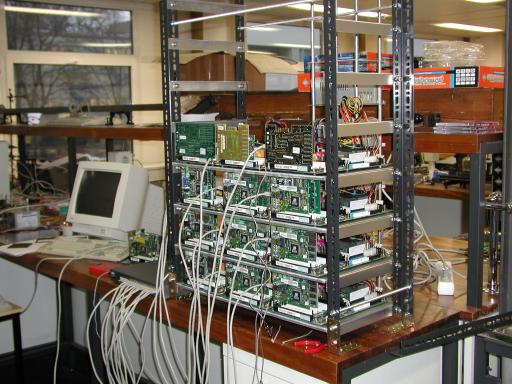Low-cost Celeron cluster
The idea behind our 24-node Celeron cluster was to build a system that
maximizes performance/cost for the type of calculations we are mainly engaged
in (quantum Monte Carlo with the stochastic series expansion algorithm).
After testing several AMD
Athlon-XP, AMD Duron, and Intel Celeron (Tualatin) processor/motherboard
configurations, we concluded that the Intel Celeron was the fastest solution
for our large-memory applications (Athlon XP was faster for our small-memory
jobs) and also cheaper than the Athlon XP (the somewhat lower price of the AMD
Duron did not make up for its significantly lower performance). In addition,
the Celeron consumes much less power, which was also a concern since the lab
space where our clusters (the 44-node Pentium III cluster as well as this
newer one) are installed is not air-conditioned. The reason for not chosing the
newer-type Celeron or Pentium IV was a combination of processor/motherboard
prices, no availability of motherboards for standard SDRAM memory, and much
higher power consumption.
A node consists of an MSI 694T motherboard, an Intel Celeron (Tualatin,
1.2 GHz) processor, 512 MB of SDRAM (a single DIMM), a 3COM (XL3C905C-TX)
network adapter, and a graphics card. In principle we would not have liked
to include a graphics card, but unfortunately this motherboard doesn't boot
without one. The solution was to collect (for free) a bunch of old spare
graphics cards from various departments and persons at Åbo Akademi. There
are no disk drives for the individual nodes; the boot code is programmed
into the network card.
Three nodes are mounted side-by-side on an aluminum plate and share
a single power supply. The eight 3-node units are stacked in a home-made
rack. The switch (SMC EZ1024DT3 EU, 10/100 TX) and the disk drives for the
master node are mounted on top of the rack.
This system was planned and designed by Anders Sandvik and Kjell-Mikael
Källman. It was built and configured by Kjell-Mikael Källman, with some help
with parts for the rack from Tom Wickström at the physics machine shop.
It was financed in part by a grant from the Research Institute at Åbo Akademi.
The total cost of the system, not including taxes or our own labor, was
approximately 6500 EUR (the components were purchased in October 2002).
|






